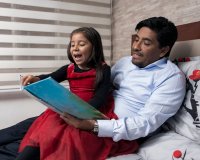For Young Brains, a Storytelling Sweet Spot
A new study uses brain scans to determine that for preschoolers, one type of story is just right.
Your content has been saved!
Go to My Saved Content.As a parent, one of my favorite activities with my toddler is storytime. These days I have plenty of good options: I can tell my son a story, we can read a picture book together, or I can turn on the TV or break out the iPad and watch a cartoon with him. At least that’s what I thought.
A new study suggests that only one these experiences hits the “Goldilocks Zone”—that sweet spot where my son’s brain is highly active, his imagination is fully engaged, and he can spare a few moments to think about the story.
The study sheds light on what happens in a young child’s brain when they’re read a story in different formats. Using fMRI machines to observe neural activity in the brain, researchers discovered that some narratives are “too cold”: Stories without pictures lack critical visual context, forcing kids to think too hard about what’s happening. Others are “too hot”: Animated stories and other fast-moving video formats (like cartoons and movies) lead to sensory overload, pushing children beyond their ability to make sense of the experience. But one format was “just right”: Picture books, which blend simple narratives with still illustrations, met the children at their developmental stage.
In the study, 27 children between 3 and 5 years old were exposed to three kinds of narratives: audio-only stories, illustrated stories, and animated stories that mixed audio and video. Using fMRI machines, researchers observed networks in areas of the brain associated with visual processing, language, imagination, and self-reflection. Researchers also examined neural activity across different areas of the brain that make meaning—they were looking at whether children were passively absorbing the story, or applying imagination to the narrative to try and make deeper sense of it.
When stories were read aloud, they were “too cold” for young children, requiring “more cognitive strain to process the story,” according to the study. Adults can easily tell the difference between pear and pair in the context of a sentence, for example, but toddlers need extra time and benefit from visual scaffolding that can help close the comprehension gap.
Animations, on the other hand, were “too hot,” bombarding children with sensory stimuli. Researchers interpreting the fMRI feedback saw little interaction between different areas of the brain, suggesting that animations were too “fast-moving”—children couldn’t keep up, spending most of their energy trying to process what they were seeing and hearing. The lesson for parents? Pay heed to the American Academy of Pediatrics (APA) guidelines on screen time for toddlers—it not only cuts into valuable family and play time, but can also affect their brains in ways that scientists are just beginning to understand.
Picture books represented a kind of happy medium (pardon the pun), and the researchers concluded that they were “just right.” The combination of spoken words and images gave children just enough scaffolding to understand the story, yielding the richest levels of story comprehension, imagination, and self-reflection.
The takeaway: For young children, not all narrative formats are created equal. Stories paired with still illustrations are a better developmental fit than text-only stories or video stories.
